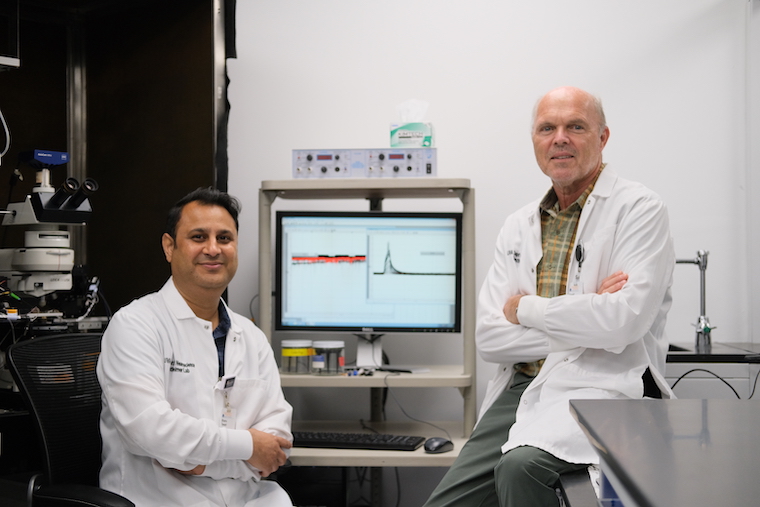
New findings from Bhanu Tewari, PhD, and Harald Sontheimer, PhD, suggest that perineuronal nets in the brain could be the key to better understanding neurological diseases such as Alzheimer's and schizophrenia.
Mysterious net-like structures that surround select neurons in the brain may be the key for better understanding and treating Alzheimer’s disease, epilepsy, schizophrenia and other neurological disorders, new research from the University of Virginia School of Medicine suggests.
The structures, called “perineuronal nets,” play a critical barrier function that is essential for neurons to communicate correctly, UVA’s new research finds. When these nets were disrupted in lab mice, the mice suffered seizures, as seen in epilepsy, and developed changes in the brain as seen in Alzheimer’s.
The findings suggest that problems with the nets could be contributing to those conditions and other neurological disorders. And that gives scientists an exciting new avenue to explore as they seek to develop better treatments for some of the most devastating diseases that afflict the human brain.
“It is remarkable that over a century after these structures were first discovered we are finally uncovering how important they are for normal brain function,” said researcher Harald Sontheimer, PhD, chairman of UVA’s Department of Neuroscience. “As these nets are readily attacked by enzymes that are released in conjunction with inflammation, this discovery will help us reevaluate the impact that tissue inflammation may have on neuronal signaling.”
Vital Safety Nets
Perineuronal nets were first discovered in 1898 by Camillo Golgi, an important early pioneer in the exploration of the nervous system. Initially dismissed by his contemporaries as a lab mistake, the nets were eventually confirmed to be real. And now findings by the Sontheimer laboratory suggest they could be far more important to our brain health than anyone has realized.
The nets surround what are known as “inhibitory” neurons. Most neurons in the brain are “excitatory,” meaning they activate other neurons. But inhibitory neurons do the opposite, acting as brakes on neuron-to-neuron communications. And the perineuronal nets are essential for that critical function, Sontheimer’s research shows.
Sontheimer and his team – led by Bhanu Tewari, PhD – found that when the nets are disrupted, a cascade of troublesome effects follow. Specialized support cells called astrocytes can no longer remove potassium or an important transmitter called glutamate from the synapse that connects neurons; this then causes glutamate to spill over where it shouldn’t be, affecting neighboring cells and possibly killing off neurons.
Sontheimer’s work suggests that tissue inflammation in both Alzheimer’s and epilepsy can trigger the loss of the perineuronal nets. The resulting defects in the neuronal “brakes” may help explain the hyperexcitability seen in the brain during epilepsy seizures and in Alzheimer’s.
It will require additional research to understand how much of a role dysfunction in perineuronal nets may be playing in human neurological diseases. But by demonstrating the essential importance of the nets for proper brain transmissions, Sontheimer and Tewari have discovered an exciting new target in the quest to develop better treatments for epilepsy, Alzheimer’s and more.
“Ongoing studies are using mouse models of Alzheimer’s disease and epilepsy to study whether drugs that attenuate inflammation can preserve perineuronal net integrity and thereby delay or even prevent disease onset,” Sontheimer said. “This research is an excellent example where a thorough microscopic reexamination of structural brain elements known for eons finally led to a novel discovery on their functional importance.”
Findings Published
Sontheimer and his collaborators at UVA and Virginia Tech have published their findings in the scientific journal Nature Neuroscience. The research team consisted of Tewari, AnnaLin M. Woo, Courtney E. Prim, Lata Chaunsali, Dipan C. Patel, Ian F. Kimbrough, Kaliroi Engel, Jack L. Browning, Susan L. Campbell and Sontheimer. The researchers have no financial interest in the work.
The research was supported by the National Institutes of Health, grants R01AG065836, R01NS036692 and R01NS123069.
To keep up with the latest medical research news from UVA, subscribe to the Making of Medicine blog.



